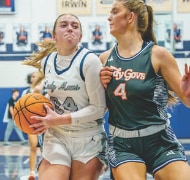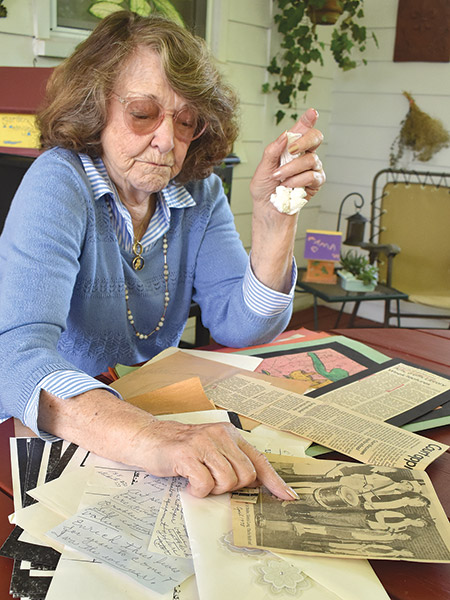Art from the attic
Art and music wasn’t all Louise Lenore Childress taught in Briceville
Take caring, a good heart, a never-say-never attitude, stubbornness, unbridled optimism, a passion to make a difference, and pour it into a slight frame with a head full of “bouncy red curls” and you might get Louise Lenore Childress.
If you’re lucky, that is.
But there is something else that needs to be mixed in with everything else to get a Louise Lenore Childress, though. It’s hard to describe, hard to fathom, really, and certainly hard to capture.
For those Briceville students who studied music and art under her for 15 years it’s there. It’s in their hearts, just as those students are in her heart.
The story of Louise Lenore Childress starts 20 years before she became an icon in Briceville — back when she was asked to do a “mission” camp at what was then Briceville Methodist Church, to organize and teach a Bible school.
“It was beautiful. That’s the first thing I thought,” Childress said. “That was before Coal Creek Watershed came in and did their wonderful work. Before the church became Briceville Church with those magnificent twin steeples.
“I fell in love with Briceville the first time I visited.”
In 1971 Briceville was deemed an economically depressed region. The coal mines had died out, or were dying out, the area was isolated, alone, and almost forgotten it seems.
But not by the Anderson County Board of Education and one Calvin Patterson. The students in Briceville were going to be the first (and only) elementary school in Anderson County at that time to have music and art.
“There was a teacher there, but I think she had an issue with her vocal chords,” Childress said. “In 1971 I started in the second half of the year,” she said. Her first full year as the music and art teacher in Briceville was 1972.
“Calvin Patterson believed in me. He believed in what it (music and art) could do for the children,” Childress said. “And the parents, the people of Briceville just opened their arms and heart to me. They were so supportive.
“They knew the importance of education, they understood that,” she said. “They still do. Briceville is so unique. It’s close-knit and it is a true community.”
But it wasn’t just “education,” the music and art Childress was teaching that would make a difference.
She taught the students to believe in themselves. She taught them that there, in a small school in an impoverished region of East Tennessee working with what Childress called “Shoe string art. Because we were always working on a shoe string budget,” she said — they could achieve anything.
And they did.
She taught them techniques that transformed the simplest crayon and construction paper drawings to a higher level. She taught her students to use what they had, from old inner tubes and burlap and folded up pieces of paper, to make truly unique art work.
And she spent time with them. One-on-one time that told these students deep in their being that they had worth.
“I think the idea was to give them self-esteem,” Childress said. “But honestly, I received more from them.”
Chidlress said art was more popular than music, especially with the older students. The older students were a little uncomfortable getting up in front of crowds and performing — they were growing in to those awkward stages of preteen.
And the music program drew crowds.
“When we had a school program the gymnasium would be packed. I don’t think you could have fit another person in there. That’s how much the parents supported those students,” Childress said.
The music program drew accolades outside of Briceville. Briceville students opened the Anderson County Fair, they marched at the front of Bicentennial Parades, they had their picture in newspapers.
“Their parents made them uniforms — not costumes — for the Bicentennial Parade and you should have seen them,” Childress said. “They were grand.”
The support of the parents was never more on display than in 1976 when it was decided the art and music programs would be shut down after the school year.
The parents rose up. The Board of Education backed down.
“It’s because of them (the parents) I’ve had the adventure I’ve had,” Childress said. “They understood what a difference we were making and they wanted to keep it.”
For 15 years Louise Lenore Childress taught, cajoled, laughed with, and inspired students. For 15 years she kept the newspaper clippings. For 15 years she “held on for safe keeping” their art work.
“I’d ask them, ‘Don’t you want to take this home?’ and they’d say, “You hang on to it for me,’” and I did,” she said.
For 15 years Louise Lenore Childress did just that. And when she retired in the mid-1980s she continued to do just that.
She’s 92 now, still as sprite and feisty as ever, still touched by the students she taught all of those years ago.
They are citizens now. Contributors to society. Business owners, workers, mothers and fathers, some are even grandparents, and they all carry the knowledge that they have “worth.”
Childress is handing back those pieces of art she has taken care of for so many years. They are at Biceville Public Library waiting for the rightful owners to come and take them back. There are some truly amazing pieces there — especially when you think about how young the artists were.
But they are more than art. They are affirmation that anything is possible, that beauty comes from something within a person and all it needs is a little coaxing to come out.



